Polypropylene Fiber Reinforced Precast Concrete Blocks for Roads and Pavements
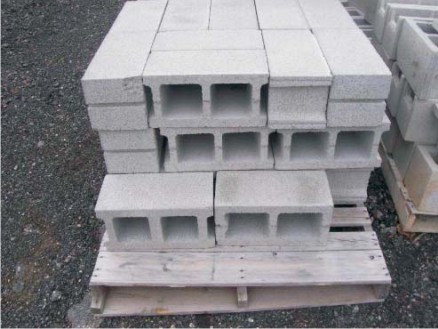
P.C.Sharma, Retd. Head Material Sciences, Structural Engg. Research Centre (G) Consultant and Concrete Technology Specialist, Editor NBMCW, New Delhi.
Roads are important infrastructure providing connectivity between cities, towns and even villages. Though there are large number of unpaved roads connecting interior villages, paved roads are convenient, comfortable in use and durable. Cities and towns have mohalla (street) roads provided to connect each locality, and to main roads. These street roads are generally provided with rigid pavements using bricks, cobble stones or cast insitu concrete. Only on wider roads flexible bitumen concrete pavements are provided because a road roller cannot reach most of the streets. Concrete pavements provided, in these narrow areas, generally suffer early damages due to
Precast Concrete Block Pavement is the answer for such situations. Block Pavements for roads is not a new concept. Brick and stone blocks have been used for this purpose in large number of our ancient buildings/sites. In many locations where roads face water stagnation causing road damages the answer to this problem is concrete Block Pavement. An example in Delhi is the pavement block road below the Railway. Bridge near Gate No 1 of Pragati Maidan successfully performing in the past many rainy seasons. This portion of road used to get seriously damaged every year causing serious traffic problem during rains. Few years ago the block pavement was provided to replace the flexible bitumen pavement and this was the end of problem. Even in very heavy rains there is no damages and problem to traffic now.
Ref. 1 has given large number of ancient and modern examples where burntclay/Naturalstone. Blocks and precast concrete bock pavements have been used successfully. The data provided for Netherland, Germany and Britain is very encouraging. Road building Technique using precast concrete blocks is already accepted and widely used in America, South Africa, U.K., Canada, Australia, New Zealand, and Japan etc and more recently in middle–east countries. Various shapes, sizes and types of blocks can be produced and used Figure 1.
In India also the use of PCC blocks, has started on a mode– rate level on city streets, petrol pumps, mall areas, bus terminals, secondary roads, car parking areas etc. In India, the precast concrete blocks are getting popular due to several reasons which can be listed as:
To overcome the problem of cracking under moving loads and for achieving high compressive/ flexural/impact strengths and absolutely zero maintenance virgin polypropylene fibers have been introduced in the casting concrete mix for mechanically cast pavement blocks. These blocks are also easy to produce using vibro pressing technique resulting additional high strength and very high resistance to cracking, impact/shock/vibration. Totally free from shrinkage/settlement cracks, damages during handling, laying and transportation. Polypropylene Fiber Reinforced Concrete is highly durable as polypropylene is totally safe in high alkaline atmosphere available in concrete environment, safe on exposure to solar radiation and free from risk of corrosion as faced in steel fiber reinforced concrete.
Several types of Polypropylene Fibers are being used in production of precast pavement by the concrete block industry which are briefly described in this paper.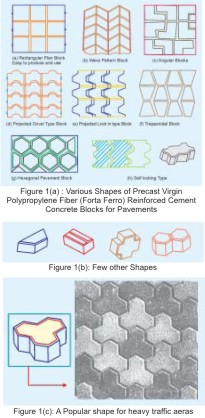 Figures 1(A) (B) (C) & (D) show several shapes of precast concrete Blocks. The polypropylene fiber reinforced concrete pavement blocks can be produced in all possible shapes and in larger sizes than plain CC Blocks. The limit to size is the handling capacity of labor. Fiber Reinforced Blocks are thinner than CC blocks as these are having much better strength.
Figures 1(A) (B) (C) & (D) show several shapes of precast concrete Blocks. The polypropylene fiber reinforced concrete pavement blocks can be produced in all possible shapes and in larger sizes than plain CC Blocks. The limit to size is the handling capacity of labor. Fiber Reinforced Blocks are thinner than CC blocks as these are having much better strength.
Breakage losses during handling and transportation at works or at job site are almost nil. In finished laid pavements also fiber Reinforced Blocks do not crack or crush as in case of plain cc blocks.
Figure 2 shows a typical cross section providing detail of a street pavement adopted by PWD and Municipal Corporations in India.
Figures 3 & 4 show Forta Polypropylene fiber reinforced concrete block pavement in a South East Asian Country. The pavement is more than 10 years old without any damages observed.
Following points are important while deciding and using precast pavement block units: Proper drainage conditions be provided to prevent water stagnation for longer durations.Precast concrete blocks pavements are generally constructed using blocks without reinforcement. If quality of concrete and the equipment used for production is not proper this may lead to cracking and even crushing of blocks and sending a wrong message against the technology. While designing a P P Block job the future traffic enhancement may be kept in view so that redoing is avoided. Using Reinforced pavment blocks is advisable for obtaining a long trouble free, durable and maintenance free service from pavement.
Proper drainage conditions be provided to prevent water stagnation for longer durations.Precast concrete blocks pavements are generally constructed using blocks without reinforcement. If quality of concrete and the equipment used for production is not proper this may lead to cracking and even crushing of blocks and sending a wrong message against the technology. While designing a P P Block job the future traffic enhancement may be kept in view so that redoing is avoided. Using Reinforced pavment blocks is advisable for obtaining a long trouble free, durable and maintenance free service from pavement.
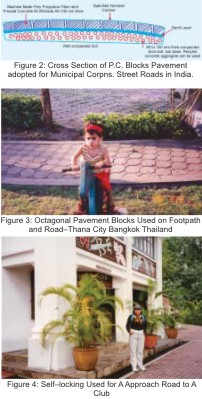 In most of the cases, block pavements are used in locations where moving loads may come. Fiber reinforcement. Blocks perform the best in such situations. These are also lighter in weight (due to reduction in thickness) hence save on transport, manpower cost and time of construction.
In most of the cases, block pavements are used in locations where moving loads may come. Fiber reinforcement. Blocks perform the best in such situations. These are also lighter in weight (due to reduction in thickness) hence save on transport, manpower cost and time of construction.
Fibers for Reinforcing Cement Concrete Construction of All Types: Many types of fibers such as steel, carbon, glass, polyester and polypropylene are now available in market for use as reinforcement (secondary) but today Polypropylene is gaining preference in use due to its merits over other types.
Standard Specification: Fibers used comply with ‘standard specifications for fiber reinforced concrete and shotcrete’ ASTM-C1116 or the available National Building code.
These fibers are being usedextensively all over the world including India for construction of various engineering structures including pavements. Two mostlyused Fibers from Forta are:-
In India, these fibers are imported and distributed by
M/s. JBA Concrete Solutions Pvt. Ltd.
135, Arjun Nagar Kotla Mubarakpur
Opp. Defence Colony, New Delhi:-110003.
Tel.:011- 41553830/20, Fax 41554130
Full technical back up and guidance is provided by manufacturers and JBA’s highly experienced specialists.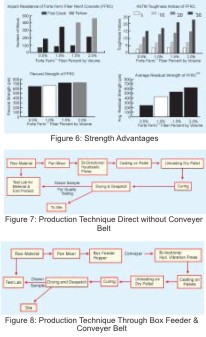 The mix for polypropylene added concrete is designed as normal concrete and Fibers are added to it. M-25, M-30 and M-35 grade concretes are generally used for getting full advantage. Addition of a plasticizer is recommended for reducing water requirement and getting improved workability.
The mix for polypropylene added concrete is designed as normal concrete and Fibers are added to it. M-25, M-30 and M-35 grade concretes are generally used for getting full advantage. Addition of a plasticizer is recommended for reducing water requirement and getting improved workability.
A Typical Mix is given here only for example for M-35grade concrete.
Produced in Figure 6 are chartstaken from "Performance Characteristics of Forta FerroTM Fiber" USA Report 2021 2000-01by Dr. V.Ramakrishna, South Dakota School of Mines and Technology-1999. This Report covers Fatigue, Toughness, Impact, Plastic Shrinkage, Flexural, Residual Strength Rebound, Compressive and Shortcrete round Panel Test.
Mechanically produced pavement blocks exhibit extra strength and durability due to proper mixing of concrete ingredients, compaction and vibration. These blocks have lower permeability (ingress of water), higher compressive, flexural strength and impact/shock resistance. The Forta Ferro fiber reinforced concrete products show almost all nil loss in form of damages during handling and transportation.
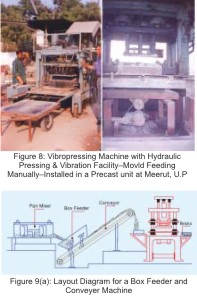 There are several types of indigenous equipment available from Indian manufacturers. These range from stationary block making machine (200 units per 8 hours with or without vibrator) to various models of bi-directional hydraulic vibro presses with production capacity of 1500 to 8000 blocks, per shift of 8 hrs. Apart from solid pavement blocks these machines can also produce hollow block, and flyash bricks. The production routes which can be opted in a plant are (1) Direct feed without conveyer Figure 6 & 8 (2) Through box feeder and conveyer. Figure 7, 9(a), 9(b).
There are several types of indigenous equipment available from Indian manufacturers. These range from stationary block making machine (200 units per 8 hours with or without vibrator) to various models of bi-directional hydraulic vibro presses with production capacity of 1500 to 8000 blocks, per shift of 8 hrs. Apart from solid pavement blocks these machines can also produce hollow block, and flyash bricks. The production routes which can be opted in a plant are (1) Direct feed without conveyer Figure 6 & 8 (2) Through box feeder and conveyer. Figure 7, 9(a), 9(b).
Refer Figures given under leading ‘Strength Advantages’ and Ref. 8 addition of Forta polypropylene fibers improves compressive strength, impact resistance, toughness, flexural strength and average residual strength and eliminates the shrinkage almost totally. Such improvements will result into highly durable and strong pavement concrete blocks. Lab and field experimentation on precast components produced and used have shown excellent results. Addition of Forta Ferro Polypropelene Fiber in concrete used for structural concrete work enhances strength, E.Q. resistance and reduces the required sections.
Road pavement blocks, crash resistant road sinages and reflective curb stones have been successfully produced and used using Forta poly–propylene fibers in India and Bhutan.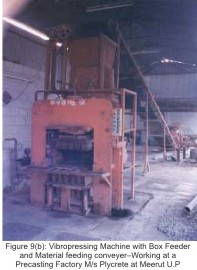 When life cycle cost analysis of concrete pavements is considered construction using polypropylene reinforced concrete blocks are cost effective as the maintenance expenditure is almost nil, life is more and strength is greatly enhanced. The designed thickness gets reduced by 10 to 20% depending upon usage and loading.
When life cycle cost analysis of concrete pavements is considered construction using polypropylene reinforced concrete blocks are cost effective as the maintenance expenditure is almost nil, life is more and strength is greatly enhanced. The designed thickness gets reduced by 10 to 20% depending upon usage and loading.
If polypropylene structural grade fiber, such as Forta Ferro, is added in casting matrix at a rate of 1Kg/M3 of concrete, the expenditure addition of amount of only Rs 600/. per M3 In a 50 mm thick block pavement the area obtained Per M3 = 1000/50=20 M2 . Hence additional cost = 600/20 = Rs 30–per M2 of pavement whereas the 50 mm PPFRC pavement can easily replace a 60-65 mm thick pavement. The thickness saved in CC will easily compensate the Additional cost incurred on fiber and also provide additional advantage of enhanced durability and need for minimum maintenance. Precast pavement blocks are being used on a very large scale in Indian town's for replacing damaged concrete pavement in streets. The damaged concrete can be broken down into recycled aggregate and used for prop of sub base successfully.
- improper mixing of ingredients and their quality
- Poor vibration (infact many times no vibration) hence poor compaction resulting poor strength and durability
- less or no curing due to difficult availability of water
- Early use by population living there. Sometimes even after 6 hours of concreting Pedestrians and Rixa etc. start using
- Poor surface finish/leveling-undulations in surface
- poor supervision generally these jobs are executed in night under poor light conditions to avoid disturbance due to day traffic.
Precast Concrete Block Pavement is the answer for such situations. Block Pavements for roads is not a new concept. Brick and stone blocks have been used for this purpose in large number of our ancient buildings/sites. In many locations where roads face water stagnation causing road damages the answer to this problem is concrete Block Pavement. An example in Delhi is the pavement block road below the Railway. Bridge near Gate No 1 of Pragati Maidan successfully performing in the past many rainy seasons. This portion of road used to get seriously damaged every year causing serious traffic problem during rains. Few years ago the block pavement was provided to replace the flexible bitumen pavement and this was the end of problem. Even in very heavy rains there is no damages and problem to traffic now.
Ref. 1 has given large number of ancient and modern examples where burntclay/Naturalstone. Blocks and precast concrete bock pavements have been used successfully. The data provided for Netherland, Germany and Britain is very encouraging. Road building Technique using precast concrete blocks is already accepted and widely used in America, South Africa, U.K., Canada, Australia, New Zealand, and Japan etc and more recently in middle–east countries. Various shapes, sizes and types of blocks can be produced and used Figure 1.
In India also the use of PCC blocks, has started on a mode– rate level on city streets, petrol pumps, mall areas, bus terminals, secondary roads, car parking areas etc. In India, the precast concrete blocks are getting popular due to several reasons which can be listed as:
- Durable and long life needing almost zero maintenance.
- Environment Friendly construction free from use of bitumen, oils and wood for heating of bitumen etc.
- Production of Precast blocks is easy, laying of the blocks, possible without use of machinery. Blocks are easy to handel and transport even in small lanes.
- Interlocking and open type joints available to suit individual situations.
- Easy to maintain or replace in case of accidental damages. The damaged units can be pulled out and new units pushed in.
- Dry joints with sand packing or mortar grouted joints are options available. Bitumen sand mix can also be used for joint packing.
- Open jointed pavement allows ground water recharge through joints.
- Does not need site curing.
- Production of pavement blocks in different color makes the pavements aesthetically pleasant.
- It consumes much less energy when compared to bitumens roads and creates zero pollution.
- Maintaining surface pevel during paying is easy.
To overcome the problem of cracking under moving loads and for achieving high compressive/ flexural/impact strengths and absolutely zero maintenance virgin polypropylene fibers have been introduced in the casting concrete mix for mechanically cast pavement blocks. These blocks are also easy to produce using vibro pressing technique resulting additional high strength and very high resistance to cracking, impact/shock/vibration. Totally free from shrinkage/settlement cracks, damages during handling, laying and transportation. Polypropylene Fiber Reinforced Concrete is highly durable as polypropylene is totally safe in high alkaline atmosphere available in concrete environment, safe on exposure to solar radiation and free from risk of corrosion as faced in steel fiber reinforced concrete.
Several types of Polypropylene Fibers are being used in production of precast pavement by the concrete block industry which are briefly described in this paper.
Shapes & Sizes of Concrete Pavement Blocks

Breakage losses during handling and transportation at works or at job site are almost nil. In finished laid pavements also fiber Reinforced Blocks do not crack or crush as in case of plain cc blocks.
Figure 2 shows a typical cross section providing detail of a street pavement adopted by PWD and Municipal Corporations in India.
Figures 3 & 4 show Forta Polypropylene fiber reinforced concrete block pavement in a South East Asian Country. The pavement is more than 10 years old without any damages observed.
Following points are important while deciding and using precast pavement block units:
- Provision of reasonably uniform and strong support sub bases and sub grades. Various types of sub grades can be used depending upon type of soil/traffic/ usage. This also govern the thickness of pavement.
- Quality controls and assurances must in place.
- Proper quality and quantity of cement, properly designed mix, proper mixing and optimum compaction, proper production technology, proper curing are essentially required for obtaining good quality blocks having long life and desired performance under actual load exposure conditions. Apart from good concrete, proper production/ casting Technique, full curing are also basic requirements for getting durable products.
- Adequate Block thickness to be provided to suit the usage pattern.

Why Use Fiber Reinforced Conc. Pavement Blocks.

Fibers for Reinforcing Cement Concrete Construction of All Types: Many types of fibers such as steel, carbon, glass, polyester and polypropylene are now available in market for use as reinforcement (secondary) but today Polypropylene is gaining preference in use due to its merits over other types.
Standard Specification: Fibers used comply with ‘standard specifications for fiber reinforced concrete and shotcrete’ ASTM-C1116 or the available National Building code.
Advantages of adding Virgin Polypropylene Fibers in Cement Concrete Pavement Blocks
Fiber reinforcement, like Forta Ferro is added in the casting matrix to- inhibit plastic and settlement shrinkage cracking prior to initial set
- to reduce hardened concrete shrinkage cracking
- improve impact strength
- increase resistance to shock & impact
- enhance concrete toughness
- as an alternate secondary/temperature reinforcement. (iv) and (v) are important in Earthquake Resistance construction.
- Configuration–shall be in fibrillated – network form
- Chemistry–shall be made of 100% virgin material in form of fully oriented polypropylene
- Contents–shall be used at a minimum dose of 900 gm/cu.m. of concrete
- Length–min. length 19 mm 38mm fiber length of 38 mm to be used in mix containing coarse aggregate of 12mm or larger.
These fibers are being usedextensively all over the world including India for construction of various engineering structures including pavements. Two mostlyused Fibers from Forta are:-
-
Forta Ferro: This structural grade Fiber consist of a twisted bundle run-fibrillating mono– filament and a fibrillating woven network fiber yielding a high performance concrete reinforcing system. In addition to all the advantages listed above this extra heavy duty fiber offers maximum long term durability, structural enhancements and effective secondary/temp crack control by incorporating a truly unique synergistic fiber system of long length design. It is non– corrosive, non magnetic, 100% alkali resistant and made of 100% virgin co–polymer/polypropylene. Mainly used with high performance concrete applications such as industrial floors, bridge decks, shotcrete work for tunnel lining or for structural rehabilitation or retrofitting jobs, precast products etc with the objective of steel reinforcement reduction or replacement.
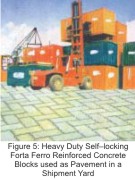
- Dosage 0.2 to 2% by volume of concrete (1.72 to 17.3kg/cubic meter of concrete) added directly to concrete mixing system during or after batching and mixed for 3 to 4 minutes. Length of fiber 54mm, SP gravity 0.91 tensile strength 620- 758 Mpa.
- Forta Econo Net: This non corrosive, non Magnetic, chemically inert and 100% Alkali, proof fiber is also used in concrete structures and pavements for reducing shrinkage in plastic and hardened concrete, improve impact resistance and concrete toughness. This is medium duty fiber and offer very good bonding power, long term durability, true secondary/ temperature. shrinkage control by incorporating a fibrillated pattern and long length option. Mainly used for applications such as subgrade, overlays/topping, curbs, slope paving, drive ways, side walks, garage floors, precast units etc. needing superior fiber performance and controlling temperature/shrinkage cracking and improving durability of structure.
In India, these fibers are imported and distributed by
M/s. JBA Concrete Solutions Pvt. Ltd.
135, Arjun Nagar Kotla Mubarakpur
Opp. Defence Colony, New Delhi:-110003.
Tel.:011- 41553830/20, Fax 41554130
Full technical back up and guidance is provided by manufacturers and JBA’s highly experienced specialists.
The Concrete Mix

A Typical Mix is given here only for example for M-35grade concrete.
- Cement Type I/II OPC ASTM-C 150/IS 1489, 383.16 kg.
- Coarse aggregate Is 238-passing 20 mm & retained on 10 mm 1161.64 kg.
- Fine Aggregate–ASTM–C-33/Is 383 Zone II 571.85 kg.
- Water/cement ratio to depend upon the process of production and plasticizer dosage–but around 0.4.
- Polypropylene Fiber Forta Ferro added depending upon application -900 to 1500 gm/m3 of concrete.
- Dose of plasticizer depending upon manufacturers Recommendation
Produced in Figure 6 are chartstaken from "Performance Characteristics of Forta FerroTM Fiber" USA Report 2021 2000-01by Dr. V.Ramakrishna, South Dakota School of Mines and Technology-1999. This Report covers Fatigue, Toughness, Impact, Plastic Shrinkage, Flexural, Residual Strength Rebound, Compressive and Shortcrete round Panel Test.
Production Techniques for Polypropylene Fiber Reinforced Pavement Blocks
Mechanized Casting Process for Pavement Blocks
For production of high quality, strong and durable concrete pavement blocks with plain or inter locking sides use of mechanized casting techniques is strongly recommended.Mechanically produced pavement blocks exhibit extra strength and durability due to proper mixing of concrete ingredients, compaction and vibration. These blocks have lower permeability (ingress of water), higher compressive, flexural strength and impact/shock resistance. The Forta Ferro fiber reinforced concrete products show almost all nil loss in form of damages during handling and transportation.

Refer Figures given under leading ‘Strength Advantages’ and Ref. 8 addition of Forta polypropylene fibers improves compressive strength, impact resistance, toughness, flexural strength and average residual strength and eliminates the shrinkage almost totally. Such improvements will result into highly durable and strong pavement concrete blocks. Lab and field experimentation on precast components produced and used have shown excellent results. Addition of Forta Ferro Polypropelene Fiber in concrete used for structural concrete work enhances strength, E.Q. resistance and reduces the required sections.
Road pavement blocks, crash resistant road sinages and reflective curb stones have been successfully produced and used using Forta poly–propylene fibers in India and Bhutan.
Cost Effectiveness

If polypropylene structural grade fiber, such as Forta Ferro, is added in casting matrix at a rate of 1Kg/M3 of concrete, the expenditure addition of amount of only Rs 600/. per M3 In a 50 mm thick block pavement the area obtained Per M3 = 1000/50=20 M2 . Hence additional cost = 600/20 = Rs 30–per M2 of pavement whereas the 50 mm PPFRC pavement can easily replace a 60-65 mm thick pavement. The thickness saved in CC will easily compensate the Additional cost incurred on fiber and also provide additional advantage of enhanced durability and need for minimum maintenance. Precast pavement blocks are being used on a very large scale in Indian town's for replacing damaged concrete pavement in streets. The damaged concrete can be broken down into recycled aggregate and used for prop of sub base successfully.
References
- Brajendra Singh, ‘Concrete block pavements for Roads’ New Building Materials & Construction World, Sept. 2007, Vol. 13, issue 3, page 170-177.
- Thickness Designs for concrete – Portland cement Association pub. ISO 10 P, 1974. Ruth, B.E. and Larsen T.J. Save money with Econocrete pavement systems’, concrete international ACI, May 1983.
- Rober G. Packard Thickness Design for concrete highway and street pavements-PCA 1995.
- Dr. V. Ramakrishnan Performance characteristics of Forta Ferro tM Fiber’, South Dakota School of Mines and Technology 1999.
- Technical Literatureon Forta Ferro- Published by FORTA Corpn. Grove City PA USE.
- ASTM-C-39 Compressive Strength, ASTM C-1018 (Static Flexural strength) ASTM C–1399 (Residual Strength).
- USA Report 20-02/F ‘Comparison of strength and toughness properties of Forta Ferro TM. Fibers and Steel Fibers reinf. Concretes” South Dakota School of mines and Technology, 2000.
NBM&CW March 2008


















